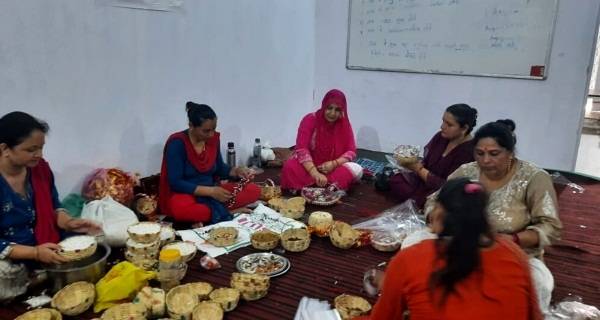The recent cloud burst and the resultant flash floods, in which several Amarnath pilgrims died, is an example of how extreme and erratic the weather can be in the region…reports Asian Lite News
Sushma Devi, a member of Baba Hardev, a self-help group (SHG) in Jammu’s Samba district, stitches raincoats and tracksuits for pilgrims visiting the Amarnath cave shrine. She’s part of a 13-member women’s group that works across different SHGs in Samba, for whom the annual yatra has become a means to ameliorate their families’ financial constraints.
The 13 members of Baba Hardev also make these garments for officials of the Shri Amarnathji Shrine Board, who are deputed at different locations in Kashmir, including the base camps of Baltal and Nunwan.
The initiative to involve these women in stitching the tracksuits and raincoats was taken after it was decided that these shrine board officials, at the base camps of the 43-day-long pilgrimage, would wear uniforms in the form of tracksuits, says Indu Kanwal Chib, director of the Jammu and Kashmir Rural Livelihoods Mission (JKRLM).
“It was also important to provide them with raincoats as the weather is unpredictable in these areas in the Valley, and monsoon is already here,” she adds.
The recent cloud burst and the resultant flash floods, in which several Amarnath pilgrims died, is an example of how extreme and erratic the weather can be in the region.
After these women provided the required material to the officials, they decided to stitch the same for the pilgrims. Within just a week of the yatra’s commencement on June 30, over one lakh pilgrims visited the holy cave shrine in Kashmir. The union territory administration permitted women in at least seven districts to set up stalls at different locations along the route. In fact, women in Samba had their stalls erected along the national highway in the district, from where the pilgrimage passes after entering Jammu & Kashmir.
Clinging to hope with ‘Umeed’
The JKRLM’s Umeed scheme aims to alleviate poverty by identifying and organising the poor and engaging them in livelihoods that enable them to tap into their potential. Its mission is to reach out to 66 per cent of the rural population across the 125 blocks of Jammu & Kashmir and link them to sustainable livelihood opportunities.
Panchayats and district development councils identify women in need for the SHGs. The government provides Rs 15,000 on the initiation of a SHG, followed by other monetary help, including Rs 40,000 as a loan to these women. They can also seek a loan to purchase raw material for the products they make.
Sushma, who has a daughter and a son, says the Baba Hardev SHG under Umeed provides her much-needed financial help to sustain her family. Her husband works as a daily wager with the Jal Shakti department, but doesn’t earn enough to sustain a family of four, including their children’s education expenses.
During other times of the year, Sushma sells homemade snacks and other eatables; this is her first time catering to the pilgrims. She’s also started a boutique at her home, where women from nearby villages come to get their clothes stitched.
Exploring various livelihood options
Women in Samba and other districts of J&K are also engaged in making bamboo products, rakhis, file covers and other handcrafted items. Before the pilgrimage, this used to be their primary source of income.
Sonia Kumari, who works with another SHG in Samba, earns Rs 4,500 to Rs 5,500 every month through the sale of bamboo buckets and other showpieces as well as sleeping bags. For the Amarnath pilgrimage, the buckets are filled with sweets that are offered to the deity as prasad and sold to the pilgrims going to or returning from the holy cave shrine.
“The women of our SHG purchase the cloth, foam and zipper to make the sleeping bags from Pathankot in Punjab as the raw material is cheaper there,” says Sonia. “We earn a profit of nearly Rs 300 on each sleeping bag. The sale has increased owing to the inflow of pilgrims, and a stall has been set up along the national highway near a prominent temple in Samba.”
Since the beginning of the Amarnath Yatra on June 30, Sonia has been earning Rs 2,500 a week just by selling sleeping bags. Members of the group divide the total money earned through the sales in accordance with the tasks they undertook.
Women prepare buckets for sanctified sweets in Samba district for people visiting the Amarnath temple.
Empowering women the SHG way
Chib says many such SHGs also operated in Kashmir, especially in the villages of Kulgam district, stitching gloves, socks and other woollens for the pilgrims.
“At least seven to eight SHGs there work towards making essentials, including raincoats, woolens and sleeping bags. The shrine board paid nearly Rs 4.5 lakh to produce them for the Amarnath officials,” she adds.
Nilofer (last name withheld on request) from Kulgam district had been struggling with financial difficulties. The 32-year-old mother of two couldn’t even afford to send her children to school till last year. Her husband works as a helper of a truck driver and is mostly away from home, travelling with his vehicle to Punjab, Haryana, New Delhi and other places.
“I joined an SHG under the Umeed scheme in the area to support my family financially. Here, we make snacks, woollen gloves and socks. The opportunity not only allowed me to earn but also provide better education to my children. While the Amarnath pilgrimage provides much needed financial support to those directly associated with it, even the SHGs providing essential items to the pilgrims are benefitting,” says Nilofer.
ALSO READ-Amarnath tragedy could have been averted

